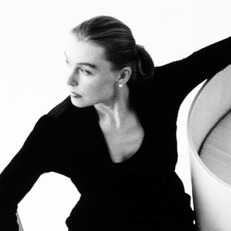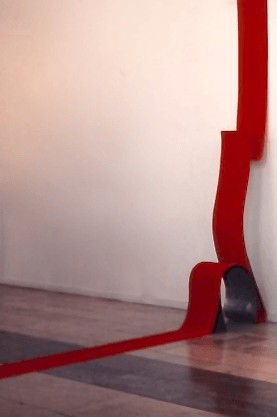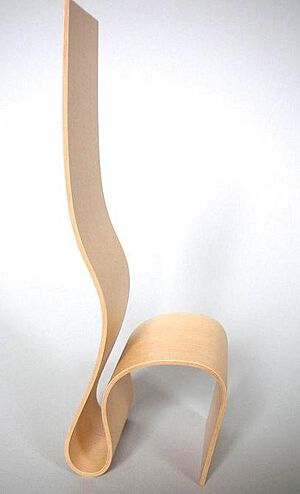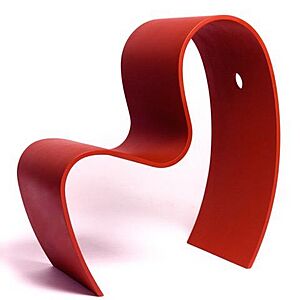Caroline Schlyter facts for kids
Quick facts for kids
Caroline Schlyter
|
|
|---|---|
 |
|
| Born |
Anna Ingrid Caroline Schlyter
October 9, 1961 Stockholm, Sweden
|
| Nationality | Swedish |
| Education | Konstfack |
| Alma mater | Royal Institute of Art |
|
Notable work
|
Little h |
Caroline Schlyter (born October 9, 1961) is a Swedish artist. She creates amazing sculptures and art installations. She's most famous for her unique furniture sculptures, which have been shown in many countries around the world.
Becoming an Artist
Caroline Schlyter studied art at two famous schools in Stockholm, Sweden. These were Konstfack and the Royal Institute of Art.
In 1988, while she was still studying, Caroline created a special chair. It was made from rolled steel and she called it Lilla h, which means Little h. This chair was first shown in Stockholm in 1989. It was part of an art installation. The chair was covered with 7 meters (about 23 feet) of red velvet fabric. This fabric flowed from the wall, over the chair, and onto the floor.
That same year, Caroline's Little h chair became famous internationally. She entered a furniture design contest in Japan. She won an award for her Little h chair. This time, the chair was made from a single piece of birch plywood. Caroline wanted to create a smooth, unbroken line without any joints.
Her design caught the attention of many magazines. Little h even appeared on the cover of several international magazines. In 1992, Caroline won the "Excellent Swedish Design" award for her Little h chair. The judges said it was almost like a "sit-sculpture." They praised how it stretched the possibilities of wood.
The h-family of Furniture
After the success of Little h, Caroline designed more furniture pieces. These were also made from single pieces of molded plywood. Together, they became known as The h-family.
This family included:
- The Lover – a comfy armchair
- The Aunt – a dressing table
- Tripp, Trapp and Trull – a set of tables
- Fido – a tea-trolley
- Little m – a child's chair
An art writer named Leo Gullbring said that Caroline's designs were very personal and original. He felt they challenged traditional Swedish furniture styles.
A big exhibition of her work, called Familjen h-son, traveled to museums. It started in Finland and then went to many museums across Sweden. A special booklet was also published for this exhibition.
Exhibitions Around the World
Caroline Schlyter's h-family furniture has been shown in many galleries and museums. Her work has traveled from Europe to Japan and even to the United States.
Some of the places her art has been exhibited include:
- The Louvre in Paris, France (1993)
- Svenskt Tenn in Stockholm, Sweden (1995)
- Aspectos in Barcelona, Spain (1997)
- Verner Amell Gallery in London, U.K. (2000)
- Gallery of Functional Art in Los Angeles, USA (2002)
- The Park Avenue Armory in New York, USA (2007)
- Design Miami/Basel in Basel, Switzerland (2011)
Her amazing work is also part of important art collections. These include the Nationalmuseum in Stockholm, Sweden, and the Vitra Design Museum in Germany. Her pieces are also at the Design Museum in London, U.K., and the V&A Museum of Childhood in London, U.K.
Other Artworks
Besides her h-family furniture, Caroline Schlyter has created many other artworks. She uses different materials and explores empty spaces in buildings.
Some of her notable installations and exhibitions include:
- Integrated Spatium (1989) – This piece featured Little h in steel and velvet.
- Sculpture 1992 (1992) – Made from glass, plaster, wood, and paint.
- The Ballerina (1993) – A bronze sculpture made for Stockholm University.
- Knock on Wood (1994) – A relief made from aluminum sheet.
- Pockory (1996) – Charcoal drawings on paper, enclosed in plastic.
- A paraphrase (1998) – A mix of photograph on canvas, charcoal, and graphite.
- Prolog (1999) – Ink drawings on paper.
- Barhäng (2006) – Made with ink, paper, and wood.
- Paradiso Inferno Purgatorio (2009) – A series of photographs.
- I miss U (2011) – A silk-screen print.
- 50-50-50 (2012) – An artwork using mixed materials.
In 2015, Caroline continued working on a project. It combines sculpture with architectural video installations. She first showed a part of this project in 2013. It was called Intermolecular Forces.




